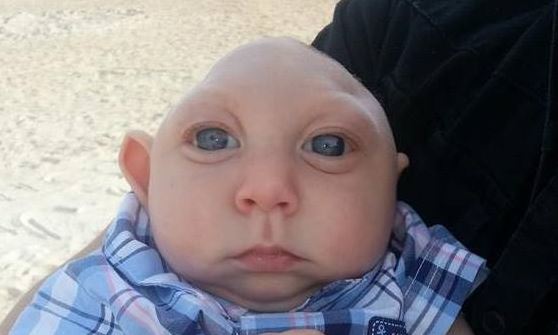When a baby is born without brain, this is a medical condition known as anencephaly. Anencephaly is one of the neural tube defects like spina bifida but it occurs on the brain end of the spinal cord and not on the butt end. Many anencephalic pregnancies end in a miscarriage, so you don't see it often in full term babies. Nearly every baby with anencephaly will die around the time of birth. According to the CDC about 1 in 5000 births will involve an anencephalic baby. Although this is highly lethal, a Florida boy, Jaxon Emmett Buell, who lost most of his skull and brain at birth has celebrated his 1st birthday and has learnt to say simple words like "mama" and "daddy". Let's pray for this little boy and at same time know more about this cruel and heartbreaking disease.

Baby Born Without Brain? What's It Like?
If a baby is born without brain, this is a serious congenital anomaly. The baby's skull is partially missing and much of the brain fails to develop. It is considered the most severe form of neural tube defect.
These are the most common findings in an anencephalic baby; however, not every baby will have all of these signs below:
- The bones on the sides and front of the head are missing.
- There is no bony cover on the back of the baby's head.
- The ears are folded forward.
- The child may have a cleft palate in which the lip and upper part of the mouth are separated in the middle.
- The baby may be born with a heart defect.
- The baby will have some simple reflexes but lacks a cerebrum, meaning the baby has no consciousness and will not live long.
There is no available treatment for anencephaly and the baby will soon die. The baby can be supported by being kept warm and by protecting the part of the brain that has become exposed to the air. The baby may also be fed with a special bottle to give it some nutrition to support its life.
What Causes Baby Born Without Brain?

This is a birth defect that occurs very early in the pregnancy, usually in the first month. This is when the woman usually doesn't even know she is pregnant. The neural tube is supposed to close early on in pregnancy and this helps create the brain and skull of the baby, the bones of the upper spine, and the spinal cord.
If the upper portion of the neural tube isn't able to close, anencephaly is the result. No one knows why this happens in some babies and not in others, but the end result is a baby born without brain. The forebrain is missing and the part of the brain associated with thought and coordination are absent. What part of the brain that does exist usually doesn't have any kind of bony or skin covering.
What Are the Risk Factors of Baby Born Without Brain?
There are some risk factors that predispose a baby to fail to close the neural tube, resulting in an anencephalic baby. Here are some factors to consider:
- Lacking Folic Acid. Since 1995, it has been discovered that a lack of folic acid can lead to a baby born without brain. Research indicates that adding folic acid does something to reduce the risk of anencephaly and other neural tube defects. Women who are trying to have a baby should take in 0.4 milligrams of folic acid per day so as to reduce the risk of having a baby with a neural tube defect.
- Certain Medication. Some medications have been linked to anencephaly and other neural tube defects. Some anti-seizure medications can cause anencephaly as well as people who are insulin-dependent diabetics.
- Family History. Neural tube defects aren't inherited in a simple way but there seems to be a hereditary pattern among families. It has been revealed that a woman who already had a child with a neural tube defect runs about a 3% chance of having another baby with some kind of neural tube defect. This is opposed to 0.1% in the general population. A woman with a baby who has had a neural tube defect should receive genetic counseling before having another baby.
- Toxins Exposure. Anencephaly has also been linked to toxic exposures to heavy metals, such as mercury, chromium, lead and nickel.
How to Detect This Condition
There are different ways to detect anencephaly. Here are some ways:
- Blood tests may detect elevated levels of alpha-fetoprotein which is usually made by the liver cells within the fetus. This is a protein that is secreted into the fluid surrounding the fetus. Except brain or spinal cord defects, high levels of alpha-fetoprotein may also indicate multiple fetuses, chromosomal disorders or a miscalculated due date.
- Amniocentesis is usually done in the second trimester of pregnancy. A needle is inserted into the amniotic fluid and draws some fluid out. The level of alpha-fetoprotein and acetyl cholinesterase can be measured. If elevated, there may be anencephaly. An amniocentesis can also be done to detect chromosomal problems or genetic defects in the fetus.
- Ultrasound examination is a commonly used imaging technique that uses sound waves and computer programming to identify the organs, tissues and blood vessels in the fetus. The ultrasound can help view the fetus' various organs and can see if the blood flow through the blood vessels is normal. The lack of a skull can also be seen as part of an ultrasound evaluation.
- Fetal MRI examination uses a strong magnet and a computer to visually see the appearance of the fetal skull. This is a better test than a fetal ultrasound when it comes to showing the fetal brain.
- After Birth Diagnosis. If the anencephaly isn't diagnosed prior to the birth, it can be readily seen after the baby is born. The skull will be missing and a part of the brainstem will be exposed.
How to Prevent Baby Born Without Brain
 Anencephaly can be partially prevented by eating foods that supply proper nutrition and by taking a prenatal vitamin even before you get pregnant. It is vital that you get enough folic acid before getting pregnant. Supplements are usually required because there usually isn't enough folic acid in the food we eat.
Anencephaly can be partially prevented by eating foods that supply proper nutrition and by taking a prenatal vitamin even before you get pregnant. It is vital that you get enough folic acid before getting pregnant. Supplements are usually required because there usually isn't enough folic acid in the food we eat.
Foods that can help deliver folic acid include dried beans, oranges, leafy green vegetables and orange juice. You can also eat fortified foods with folic acid. Synthetic folic acid is better absorbed than the folic acid you get in the foods you eat. It is required that all cereal products be fortified with folic acid by the US FDA.
If you have had an infant with a neural tube defect, the doctor may have you take greater amounts than most people throughout the pregnancy. Ask the doctor about how much folic acid you should take. In women who have had a neural tube defect baby, it is estimated that 4 milligrams of folic acid be taken at least 2 months prior to becoming pregnant again.